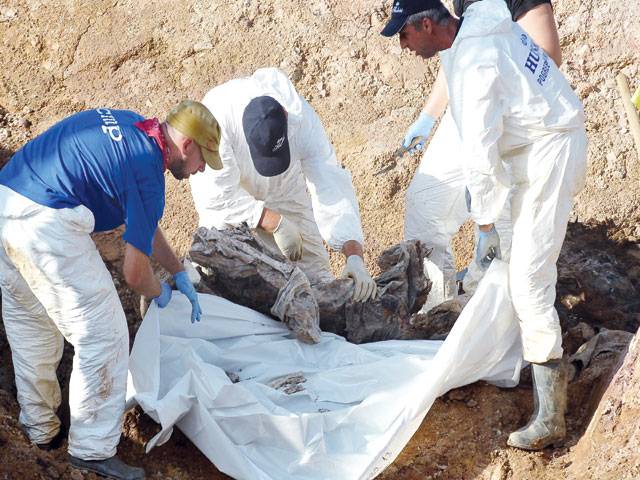Rusmir Smajilhodzic - Suad Zeric stares expectantly at a corpse exhumed from a gaping, freshly-dug hole where hundreds of Muslims and Croats massacred in the Bosnian war were tossed two decades ago.
The body, surrounded by forensic experts, may be his uncle or his cousin, both of whom disappeared in the ethnic-driven mayhem of the 1992-95 conflict that followed the breakup of the old Yugoslav federation. “I hope with all my heart that they will be found here,” said the 57-year-old, a survivor of the most notorious Serb-run detention camps set up during the war.
The grave was discovered in April in a disused mine in the village of Tomasica in the northwestern region of Prijedor. Exhumation work started in September in what is the biggest mass grave found in the region. “One of my four uncles who were murdered by cowards, Fehim, was discovered here, thank God,” he said in a whisper, his voice breaking with emotion.
“Kasim, his son Emsud, my uncle Salih and another, Latif, are still missing,” said Zeric, whose father’s remains were only found a few years ago in another mass grave.
The Bosnian, who now lives in the eastern French town of Mulhouse but returns home two or three times a year, was held in both the Omarska and Keraterm camps. These, with the Trnopolje camp, formed what became known as the war’s “triangle of horror” from which many detainees never reappeared.
Bosnian Serb forces set up the three camps, all in the northwest, at the start of the war, which claimed 100,000 lives and left a legacy of ethnic and political divisions that carry on today.
It was photographs of emaciated prisoners at Omarska - reminiscent of Holocaust victims in Nazi death camps - first broadcast in the summer of 1992 that shocked the world and drew international attention to the Serb campaign of so-called “ethnic cleansing”.
Zeric was detained in May 1992 in Kozarac, near Prijedor, a month after Bosnian Serbs began their siege of Sarajevo. He was first sent to Keraterm camp then transferred a week later to Omarska, a site in an old iron mine he describes as “hell”. Later on he was taken to Manjaca, another camp set up by the Bosnian Serb wartime authorities.
The grave at Tomasica, which lies 20 kilometres from the city of Prijedor, was discovered by the Bosnian Institute for Missing People based on information from former Bosnian Serb soldiers. The Institute is still searching for 1,200 people from the 3,000 who went missing in the area during the war.
“Since the start of exhumation work, on September 3, we exhumed 240 victims, and among them 170 complete bodies,” the Institute’s spokeswoman Lejla Cengic told AFP.
She said incomplete skeletons were those of victims moved from Tomasica to another grave in nearby Jakarina Kosa to try to cover up the crimes.
The remains of 373 people were exhumed from that grave in 2001, said Cengic, who said the bodies had been shattered by bulldozers used by Bosnian Serb forces during the move.
‘A desire to kill’
Forensic experts continue to exhume “hundreds of victims” at the Tomasica site, said the spokeswoman, saying it is not only the biggest mass grave found in the region but may become the largest ever found in Bosnia.
The biggest gravesite so far was discovered in 2003 in Crni Vrh, in the country’s east, where the remains of 629 people were recovered. Bosnian Serbs took control of the Prijedor region in April 1992, forcing non-Serbs to leave their homes which they then destroyed.
Families were separated and thousands of people were thrown into detention camps, held in squalid living conditions, many tortured, many executed. In the Prijedor area alone more than 1,500 people died in the camps of Omarska, Trnopolje and Keraterm.
Twenty years on, some of the bodies at Tomasica are surprisingly practically intact, said forensic expert Mujo Begic.
“This is due to the composition of the soil and also because the bodies were very deep. They were found 10 to 12 metres (33-39 feet) under the earth,” he said.
Still traumatised by his time in Omarska where he said he was regularly beaten, Zeric, a Muslim, has found peace in his faith. “I will never understand this desire to kill,” he said.
“An animal stops when it catches its prey. They (the Serb forces running the camp), never had enough of death. I hope that no one else on the planet lives through what we have lived,” he said. –AFP
Friday, April 19, 2024
New mass graves raise hope for the missing in Bosnia

8:27 AM | April 19, 2024
8:09 AM | April 19, 2024
IMF urges Italy, France to spend less, Germany to loosen purse strings
8:57 PM | April 19, 2024
PM calls UAE president, admires Emirati leadership's response to recent Dubai rains
8:55 PM | April 19, 2024
Church leader calls for including Christians in Gandhara Corridor
8:50 PM | April 19, 2024
Empowering Women: The Vision of Maryam Nawaz Sharif
8:37 PM | April 19, 2024
President Zardari confers Nishan-i-Imtiaz (M) award on Turkish CGS
8:23 PM | April 19, 2024
A Tense Neighbourhood
April 19, 2024
Dubai Underwater
April 19, 2024
X Debate Continues
April 19, 2024
Hepatitis Challenge
April 18, 2024
IMF Predictions
April 18, 2024
Kite tragedy
April 19, 2024
Discipline dilemma
April 19, 2024
Urgent plea
April 19, 2024
Justice denied
April 18, 2024
AI dilemmas unveiled
April 18, 2024
ePaper - Nawaiwaqt
Advertisement
Nawaiwaqt Group | Copyright © 2024





